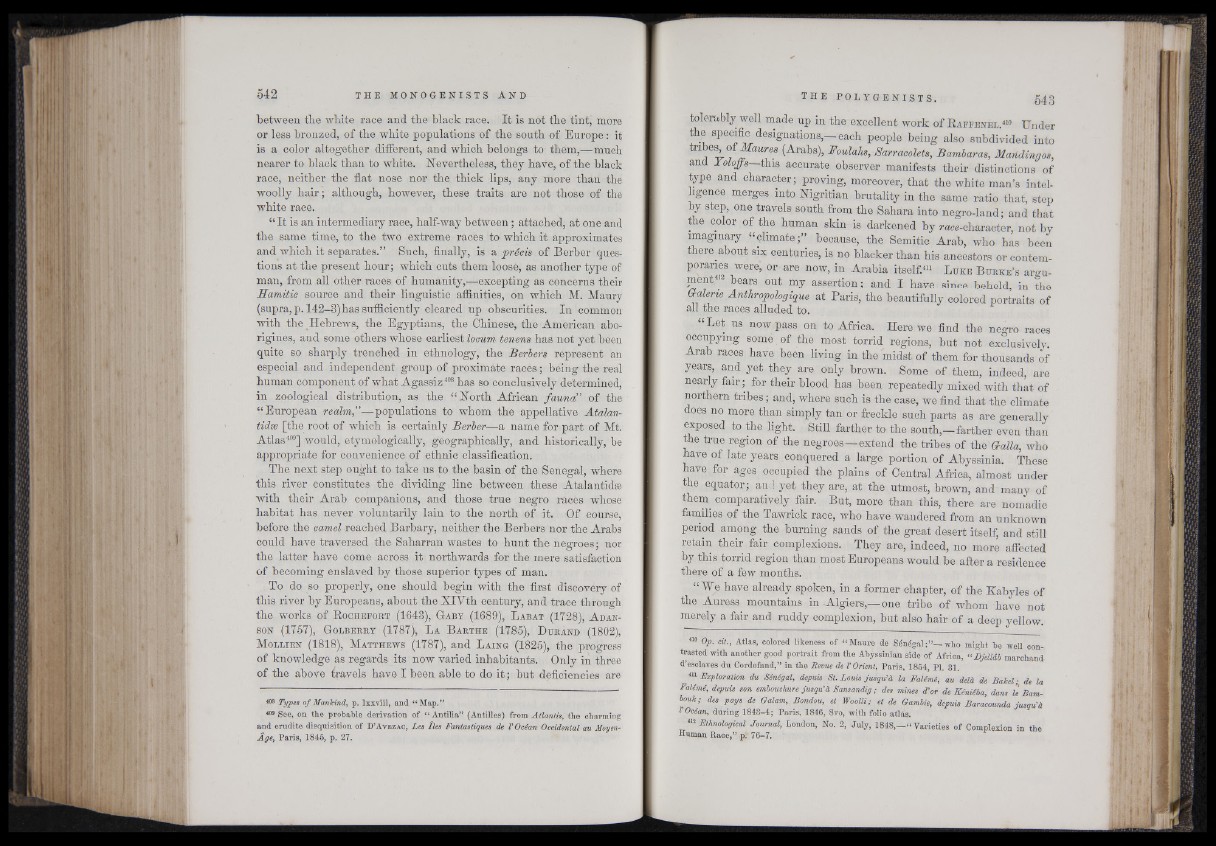
between the white race and the black race. It is not the tint, more
or less bronzed, of the white populations of the south of Europe : it
is a color altogether different, and which belongs to them,—much
nearer to black than to white. Nevertheless, they have, of the black
race, neither the flat nose nor the thick lips, any more than the
woolly hair; although, however, these traits are not those of the
white race.
“ It is an intermediary race, half-way between ; attached, at one and
the same time, to the two extreme races to which it approximates
and which it separates.” Such, finally, is a précis of Berber questions
at the present hour; which cuts them loose, as another type of
man, from all other races of humanity,—excepting as concerns their
Hamitic source and their linguistic affinities, on which M. Maury
(supra, p. 142-3) has sufficiently cleared up obscurities. In common
with the Hebrews, the Egyptians, the Chinese, the American aborigines,
and some others whose earliest locum tenens has not yet been
quite so sharply trenched in ethnology, the Berbers represent an
especial and independent group of proximate races ; being the real
human component of what Agassiz 408 has so conclusively determined,
in zoological distribution, as the “ North African fauna” of the
“ European realm,”—populations to whom the appellative Atalan-
tidse [the root of which is certainly Berber—a name for part of Mt.
Atlas409] would, etymologically, geographically, and historically, be
appropriate for convenience of ethnic classification.
The next step ought to take us to the basin of the Senegal, where
this river constitutes the dividing line between these Atalantidæ
with their Arab companions, and those true negro races whose
habitat has never voluntarily lain to the north of it. Of course,
before the camel reached Barbary, neither the Berbers nor the Arabs
could have traversed the Saharran wastes to hunt the negroes; nor
the latter have come across it northwards for the mere satisfaction
of becoming enslaved by those superior types of man.
To do so properly, one should begin with the first discovery of
this river by Europeans, about the XlVth century, and trace through
the works of R ochefort (1643), G aby (1689), L abat (1728), A dan-
son (1757), G olberry (1787), L a B arth e (1785), D u r a n d (1802),
M ollien (1818), M atthews (1787), and L a in h (1825), the progress
of knowledge as regards its now varied inhabitants. Only in three
of the above travels have I been able to do it ; but deficiencies are
408 Types of Mankind, p. lxxviii, and “ Map.”
409 See, on the probable derivation of “ Antilia” (Antilles) from Atlantis, the charming
and erudite disquisition of D’Avezac, Les îles Fantastiques de V Océan Occidental au Moyen-
Âge, Paris, 1845, p. 27.
tolerably well made up in the excellent work of R a f f e n e l .410 Under
the specific designations,-each people being also subdivided into
n , e^ ° aures (Arabs), Foulahs, Sarracolets, Bcimbaras, Maridingos,
an 0 offs this accurate observer manifests their distinctions of
type and character; proving, moreover, that the white man’s intel-
hgence merges into Nigritian brutality in the same ratio that, step
by step, one travels south from the Sahara into negro-land; and that
the color of the human skin is darkened by race-character, not by
imaginary “ climate;” because, the Semitic Arab, who has been
there about six centuries, is no blacker than his ancestors or contemporaries
were, or are now, in Arabia itself.411 L uk e B u r k e ’s argument412
bears out my assertion; and I have since beheld, in the
G-alerie Anthropologique at Paris, the beautifully colored portraits of
all the races alluded to.
Let us now pass on to Africa. Here we find the negro races
occupying some of the most torrid regions, but not exclusively.
Arab races have been living in the midst of them for thousands of
years, and yet they are only brown. Some of them, indeed, are
nearly fair ; for their blood has been repeatedly mixed with that of
northern tribes ; and, where such is the case, we find that the climate
does no more than simply tan or freckle such parts as are generally
exposed to the light. Still farther to the south,—farther even than
the true region of the negroes—extend the tribes of the G-alla, who
have of late years conquered a large portion of Abyssinia. These
have for ages occupied the plains of Central Africa, almost under
, he equator; and yet they are, at the utmost, brown, and many of
thein comparatively fair. But, more than this, there are nomadic
families of the Tawrick race, who have wandered from an unknown
period among the burning sands of the great desert itself, and still
retain their fair complexions. They are, indeed, no more affected
by this torrid region than most Europeans would be after a residence
there of a few months.
“We have already spoken, in a former chapter, of the Kabyles of
the Auress mountains in Algiers,—one tribe of whom have not
merely a fair and ruddy complexion, but also hair of a deep yellow.
Op. cit., Atlas, colored likeness of “ Maure de S é n é g a l who might be well contrasted
with another good portrait from the Abyssinian side of Africa, “Djelldb marchandd’esclaves
du Cordofand,” in the Revue de V Orient, Paris, 1854 PI. 31.
411 Exploration du Sénégal, depuis St. Louis jusqu’ à la Falémé, au delà de Bdkél; de la
Falémé, depuis son embouchure jusqu' à Samandig ; des mines d'or de Kéniêba, dans le Bam-
bouk; des pays de Galam,. Bondou, et Woolli; et de Gambie, depuis Baracounda jusqu'à
l Océan, düring 1843-4; Paris, 1846, 8vo, with folio atlas.
412 Ethnological Journal, London, No. 2, July, 1848,— “ Varieties of Complexion in the
Human Race,” p.* 76-7.